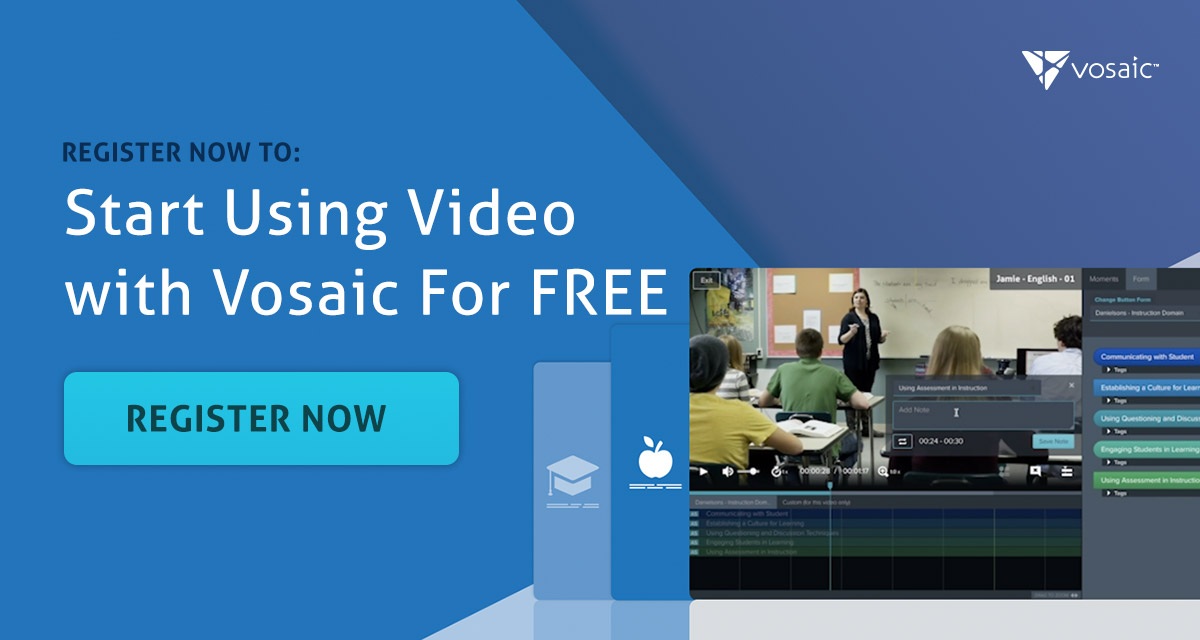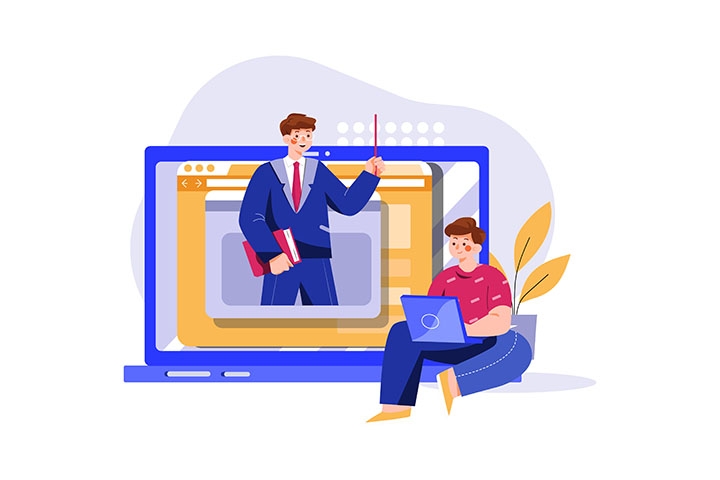It’s something colleges of education know: video is the path to success in teacher growth, and it’s the way of the future (and present, I might add). Teacher licensure exams are exceedingly requiring video recording of, and reflection on, practice. Assignments in undergraduate courses are often completed through a video submission and subsequent reflection. The same principles that make video analysis effective for pre-service teacher growth apply to post-grad teachers as well, and many K-12 districts are taking professional development through teacher coaching with video by storm.
In their research summary “How to ensure high-quality instructional coaching at scale,” Andrew Wayne and Jane Coggshall describe the value of instructional coaching, along with the phenomenon that, as coaching programs scale up, success drops. “That’s no surprise to those who lead school systems,” they write. “District leaders may be able to identify one or two extraordinary coaches with the magic touch, but other coaches don’t succeed consistently.”
“District leaders may be able to identify one or two extraordinary coaches with the magic touch, but other coaches don’t succeed consistently.”
Video provides the solution. Using video, districts can utilize coaches with amazing track records, instead of working with only those in their geographical boundaries (and paying for their travel expenses). Using a web platform also enables administrators to monitor the coaching. In the previously mentioned study, the researchers describe the ideal online platform. Such a platform allows teachers to upload classroom videos, and coaches to attach comments, questions, and prompts to specific moments within those videos. Teachers can then respond to those prompts before an actual coaching session takes place.
Stay on Top of Important Discoveries
We read case studies and academic journals so you don’t have to. Sign up and we’ll send you the key takeaways.
Video allows for flexibility in coach/teacher time, compels us to action, facilitates data collection, propels student achievement, and eliminates bias. There’s also plenty of evidence to suggest that instituting more thorough measures of professional development like video coaching actually decreases teacher turnover. Despite this long list of benefits, schools and districts have trouble obtaining teacher buy-in.
Why Don’t Teachers Love Video Coaching?
Why don’t teachers always love the idea of video coaching? To start, teachers who have given video coaching time and effort often do love it. However, the moment you saw the words “video,” and “teacher growth,” in this blog, your skin may have crawled. That makes sense; it’s challenging to look at ourselves plainly and confront reality due to a little psychological habit called confirmation bias. Confirmation bias is a natural tendency to seek data that confirms our beliefs, which gets more difficult to do when we’re faced with the kind of clarity that a video of ourselves teaching provides.
Besides confirmation bias, we also have to confront habituation, which desensitizes us to our everyday actions because they’ve become second nature, or habitual. We conjure up an image of what we think it looks like when we complete our work. Video will undoubtedly show us some evidence to the contrary. In fact, video impacts our very identity, because the truth is that we can see our flaws in video footage - and that’s the point. There is no possible chance for professional growth without first understanding where in our professional life we can grow.
Finally, teachers just aren't used to using video for self-reflection and growth! The education community may argue that most professions don’t require this “invasion” or “monitoring.” However, there aren’t many careers in which one professional, behind a closed door, is responsible for the education of many small humans. It’s a really important job, and accountability and continued growth is required in important jobs.
Achieve Teacher Buy-In With These 9 Steps
Though teachers may avoid using video to improve their practice at first, there are a few practical steps you can take to help foster teacher buy-in. Follow these steps, and watch teacher growth, and subsequent student achievement, flourish.
1. Share your competency
Understand the science behind teacher coaching with video, and share why you’re making this opportunity available in detailed messaging. If you plan to announce a video-coaching program in a meeting, make sure you also send a follow-up email with your sources. One fantastic option for your personal research is linked here.
2. Eliminate hypocrisy and establish vulnerability
You’ve heard the phrase “lead by example.” In this case, leading by example means recording your own videos to self-reflect and be coached on. That can and should include stepping into the classroom yourself and taking over teaching a few lessons, then having a discussion with the class's regular teacher about what you could improve. An alternative option is to record a video of yourself leading a meeting and use the footage for self-reflection. If you plan to utilize coaches, insist that the coaches themselves are coached on their practice as well.
3. Communicate coaches’ abilities
Ensure your coaches are qualified, whether they are peer coaches or outsourced. Simply sharing credentials, years of teaching experience, and past coaching success will go a long way in establishing trust.
4. Relay transparent expectations
Start by taking the pressure off. Let your teachers know that you recognize the complex nature of teaching and that video observation is for their benefit - not to their detriment. Clearly explain what video submissions are for coaching and self-reflection only, and which are being used to fulfill regular teacher evaluations, if any. Create a defined coaching cycle with a beginning and end, communicating the exact amount of time teachers will need to invest, including both personal reflection and coaching time.
5. Enlist Volunteers Only
Introduce the coaching cycle at your school or district, enlisting only volunteers. Even if there are only one or two teachers willing to record, self-reflect, and engage in coaching, word of the benefits and success of the program will spread. At the next teacher in-service or general meeting, have volunteers share their real experiences and ask if additional teachers would like to experience the free professional development opportunity available through video coaching.
6. Establish the focus of a coaching session before-hand
Don’t allow peers, administrators, or coaches to begin a video coaching session with a surprise rubric. Instead, video analysis should occur in cycles that foster deliberate practice. First, confirm which one or two skills will be the focus of a lesson. Next, teachers can record their classroom practice, intentionally attempting to apply those skills. Then, they can reflect on the video during a low-stakes self-observation, commenting their initial thoughts utilizing a user-friendly video analysis tool. Coaches can review both the videos and the teachers’ comments, adding their own. Finally, coaches and teachers can meet in person or via video conference to discuss. They can also decide whether to continue honing the established skills or to begin working on new skills.
Focus more on observable, measurable, data-driven aspects of teaching and learning to create an unbiased experience of improvement for teachers.
7. Give growth preference to teachers
If teachers are already conscious of areas of growth they’d like to work on, allow them to focus on those facets of their teaching first. They will be more invested if they have the control over their journeys.
8. Take advantage of a video analysis platform
Video analysis helps teachers create gains in their practice, but it comes with roadblocks if you begin without the right tools. Vosaic’s teacher coaching software provides a mechanism for teachers to more efficiently obtain feedback and leave their own reflective comments for future reference. Leave video or text comments tied directly to moments within the video. These moments can be simple tags or video clips with a duration that teachers precisely determine.
With Vosaic, video recording, uploading, and sharing itself is simplified. When feedback is linked to specific moments in classroom videos, teacher-coach alliances are easily built, and everyone is on the exact same page. Create a highlight reel, replaying only the most important moments to save time.
Easy-to-use technology eliminates friction and saves instructional coaches’ time (and district funds) with asynchronous video-based coaching.
9. Allow teachers complete control of the recording process
Teachers may initially believe that recording their classroom practice will be intimidating, but they’ll be surprised how much less intimidating it is than having a physical observer in their classroom. Besides introducing pressure, physical observers change the atmosphere of the classroom, causing students and teachers to behave differently than they normally would.
When teachers have complete control of the recording process - using devices they are already comfortable and confident with, and re-recording as much as they want to, they can let their guards down and relax, capturing more of their natural teaching style.
If you don't have a Vosaic account for teacher coaching and observation, you can start with a free trial today.
Improving professional development initiatives at your school with video doesn’t have to be intimidating. Having a plan of action to execute step-by-step can propel your school or district into a future of less teacher turnover and higher student achievement. Dr. Gregory Betts, Director of Professional Learning at Westside Community Schools put it this way:
“With Vosaic, our coaches and principals can easily record and annotate videos to provide timely, highly specific, and objective feedback to teachers about their practice. It’s the only platform that provided us with the flexibility we needed from video.”




